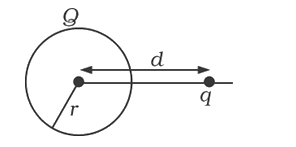Consider two solid dielectric spheres of radius a, separated by a distance R(R>>a). One of the spheres has a charge q, and the other is neutral (see figure). We double the distance between two sphere. How much charge should reside on the first sphere now so that the force between the spheres remains the same ?

The correct Answer is:q'=4√2q
Step by step video & image solution for Consider two solid dielectric spheres of radius a, separated by a distance R(R gt gt a). One of the spheres has a charge q, and the other is neutral (see figure). We double the distance between two sphere. How much charge should reside on the first sphere now so that the force between the spheres remains the same ? by Physics experts to help you in doubts & scoring excellent marks in Class 12 exams.
Updated on:21/07/2023Topper's Solved these Questions
- ELECTROSTATICSBOOK - RESONANCE ENGLISHCHAPTER - ELECTROSTATICSEXERCISE - Part - II
23 Videos
- ELECTROMAGNETIC INDUCTIONBOOK - RESONANCE ENGLISHCHAPTER - ELECTROMAGNETIC INDUCTIONEXERCISE - A.l.P
19 Videos
- EXPERIMENTAL PHYSICSBOOK - RESONANCE ENGLISHCHAPTER - EXPERIMENTAL PHYSICSEXERCISE - PART -II
10 Videos
Similar Questions
Two conducting spheres of radii 3 cm and 1 m are separated by a distance of 10 cm in free space. If the spheres are charged to same potential of 10 V each, then the force of repulsion between them is
View SolutionThere are two uncharged identicasl metallic spheres 1 and 2 of radius r separated by a distance d(d>>r). A charged metalllic sphere of same radius having charge q is touched with one of the sphere. After some time it is moved away fom the system. Now, the uncharged sphere is earthed. Charge on earthed sphere is
View Solution
Knowledge Check
Consider two conductinbg spheres of radill R1andR2 with R1>R2. If the two are at the same potential, and the larger sphere has more charge than the smaller sphere, then
Athe charge density of smaller sphere is less then that of larger sphere,Bthe charge density of smaller sphere is more than that of larger sphere.Cboth spheres may have same charge density.Dnone of these
Two charges spheres are separated at a distance d exert a force F on each other, if charges are doubled and distance between them is doubled then the force is
View SolutionA solid metal sphere of radius R has a charg +2Q. A hollow spherical shell of radius 3R placed concentric with the frist sphere has net charge -Q.

What would be the final distribution of charges if the sphres are joined by a conducting wire
View SolutionConsider two conducting spheres of radii R1andR2 with R1>R2. If the two are at the same potential, the larger sphere has more charge than the smaller sphere. State whetehr the charge density of the smaller sphere is more or less than that of the larger oe.
View SolutionThe electrostatic force on a small sphere of charge 0.4μC due to another small sphere of charge −0.8μC in air 0.2 N (i) What is the distance between the two spheres? (ii) What is the force on the second sphere due to the first ?
View SolutionTwo identical conducting spheres are charged by induction and then separated by a large distance, sphere 1 has charge +Q and sphere 2 has charge -Q. A third sphere is initially uncharged. If sphere 3 is touched to sphere 1 and separated and then touched to sphere 2 and separated what is the final charge on each of the three spheres?
View SolutionA hollow sphere of radius 2R is charged to V volts and another smaller sphere of radius R is charged to V/2 volts. Now the smaller sphere is placed inside the bigger sphere without changing the net charge on each sphere. The potential difference between the two spheres would be
View SolutionA solid conducting sphere of radius r is having a charge of Q and point charge q is a distance d from the centre of sphere as shown. The electric potential at the centre of the solid sphere is :

View Solution
